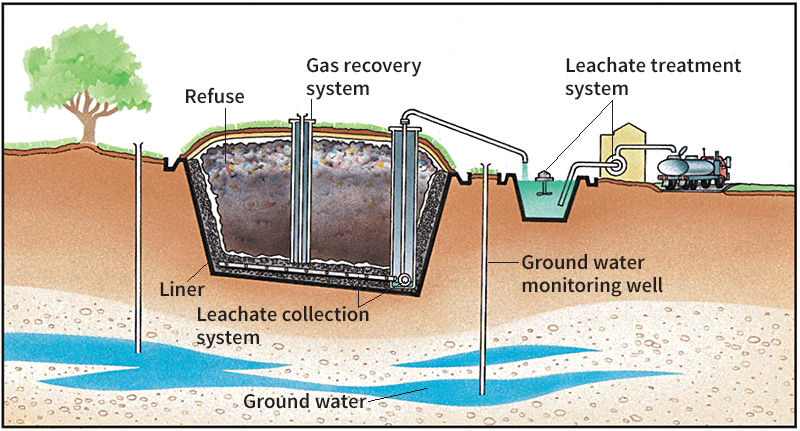Waste disposal is the process of removing waste materials. People produce several kinds of waste. There is gaseous waste, such as carbon monoxide from cars. There is liquid waste, such as sewage. There is also solid waste. The many kinds of solid waste include paper and plastic products, bottles and cans, food scraps, and junked automobiles. Solid waste is also called refuse, garbage, rubbish, or trash. If not disposed of properly, it looks unattractive and smells foul. It may contaminate the environment. It may also cause health hazards.
Solid waste from homes, offices, restaurants, and stores is called municipal solid waste. This article discusses how to dispose of such waste. Solid waste also comes from industries and farms. For information on these sources of waste, see the World Book article on Environmental pollution. See also the Sewage article for information on the disposal of waste matter from sinks and toilets.
Most cities and towns gather municipal solid waste from homes and other buildings. The collection is done by waste-collecting departments or private firms. Trash haulers remove the waste in trucks. Disposing of municipal solid waste has become a problem because people produce more each year. Also, few people want to live or work near a waste disposal site. For this reason, it grows increasingly difficult to find locations for new sites.
Communities use three chief methods to process and dispose of municipal solid waste. These methods are recycling and waste reduction, burning, and land disposal. In the United States, about 35 percent of solid waste is recycled. About 15 percent is burned. About 50 percent is buried in landfills. The United Kingdom recycles or composts about 45 percent of its solid waste.
Recycling and waste reduction
help lessen the amount of waste that is burned or buried. Recycling is the process of reusing materials instead of throwing them away. Commonly recycled materials include metals, glass, and paper. Waste reduction is the process of producing less waste. For example, people can reduce waste by buying items that last longer or have less packaging. See Recycling.
Loading the player...
Paper recycling
Loading the player...
Aluminum recycling
Burning
is the destruction of waste products by fire in furnaces called incinerators. Burning is also known as incineration. Some large cities use incinerators because they do not have suitable areas nearby for land disposal sites. In the United States, Canada, and many European countries, incinerators must limit the amount of pollution they release. Incineration plants must properly handle the ash they produce. They must also monitor the ash to ensure that it will not harm the environment. Most incineration plants use the heat from burning waste to produce steam. The steam can drive electric power generators or provide heat for buildings or industrial processes.
Land disposal
involves hauling garbage to an area owned by a community or a private firm. Such areas include open dumps, sometimes called unsanitary landfills. Properly operated disposal sites are called sanitary landfills.

Open dumps provide a poor method of waste disposal. They harm the environment and cause human health risks. They can ruin an area’s appearance and may produce bad odors. In addition, rain water that drains through refuse can carry harmful substances to nearby water. The burning of wastes at unregulated dumps can produce smoke and foul odors. Decomposing wastes produce a flammable gas called methane. Methane explosions can result. In many industrialized countries, it is illegal to create a new open dump. In the United States, the Environmental Protection Agency is phasing out open dumps.
Sanitary landfills are designed to protect the environment by sealing off waste material. Each day, landfill operators pack the waste firmly. They cover it with earth or specially manufactured materials. When a site fills up, the operator spreads it with dirt. Sometimes, the site is first covered with a plastic membrane. Many communities then use such sites for recreational purposes.
Tightly packed and covered landfills have limited water and oxygen. For these reasons, many waste materials decompose (break down) slowly. As materials decompose, they release gases into the air. They also release compounds that dissolve into the water in the landfill. Landfill operators monitor and control the release of gases and water to prevent pollution. Modern landfills have liners of plastic or clay to hold in contaminated water. A drainage system pumps out rain water that collects in the landfill. The system transfers the water to a treatment plant for removal of contaminants.
